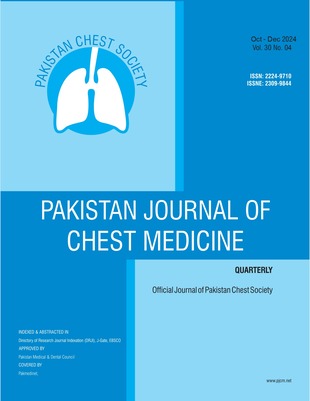Evaluation of Pleurodesis Success in Malignant Pleural Effusion Using Radiologic Modalities: The Role of Thoracic Ultrasound, CT, and Chest X-Ray
Keywords:
Malignant Pleural Effusion, Pleurodesis, CT, X-RayAbstract
Background: Malignant pleural effusion (MPE) is a frequent issue in advanced cancers. It leads to serious breathing problems and reduces the quality of life. Doctors often use chemical pleurodesis to prevent the fluid from returning. Assessing how well pleurodesis works is important for clinical decisions. Imaging methods like ultrasound, computed tomography (CT), and chest X-ray are key for checking results after the procedure. Objective: To evaluate the effectiveness of pleurodesis in patients with malignant pleural effusion using thoracic ultrasonography, computed tomography, and chest radiography, focusing on the absence of pleural sliding as a sign of successful treatment. Methodology: This study was performed at the Department of Medicine, Kabir Medical College, Peshawar. Fifty-four patients with malignant pleural effusion had intercostal chest tubes inserted, and then underwent chemical pleurodesis with bleomycin. Transthoracic ultrasound was done by researchers before the procedure, and again one month later to assess for the pleural sliding sign. Chest X-rays and CT scans also aided in determining the success of the pleurodesis. Results: Out of the 54 patients, 43 (79.6%) had successful pleurodesis. This was signified with no pleural sliding on ultrasound, a lack of recurrence of pleural effusion on CT and X-ray. In the mammary and supra-mammary regions, 81.5% had loss of sliding. Axillary and posterior regions, 77.8% and 75.9% loss of sliding, respectively. There was no significant difference in the results based on the type of sclerosing agent employed in the procedure. Conclusion: Transthoracic ultrasound is a trustworthy and effective non-invasive tool to evaluate the success of pleurodesis in malignant pleural effusion; the loss of the pleural sliding sign is associated with effective pleural adhesion. The CT and X-ray assessments support the ultrasound findings and use of sclerosing agent type did not significantly influence outcomes of pleurodesis.References
Roberts ME, Neville E, Berrisford RG, Antunes G, Ali NJ. Management of a malignant pleural effusion: British Thoracic Society Pleural Disease Guideline 2010. Thorax. 2010;65 Suppl 2:ii32–ii40. DOI: 10.1136/thx.2010.136994.
Thomas R, Cheah HM, Rajalingam V, D’Cruz A, Steinke K. Malignant pleural effusion – A review of current management strategies. Heart Lung Circ. 2022;31(5):683–693. DOI: 10.1016/j.hlc.2021.12.001.
Bielsa S, Porcel JM. Prognostic models in malignant pleural effusion. Curr Opin Pulm Med. 2014;20(4):352–357. DOI: 10.1097/MCP.0000000000000072.
Fysh ETH, Lee YCG. Pleurodesis for malignant pleural effusions: improving success rate and patient outcomes. Curr Opin Support Palliat Care. 2013;7(4):352–358. DOI: 10.1097/SPC.0000000000000012.
Rodriguez-Panadero F, Montes-Worboys A. Mechanisms of pleurodesis. Respiration. 2012;83(2):91–98. DOI: 10.1159/000329992.
Light RW. Pleural diseases. 6th ed. Philadelphia: Lippincott Williams & Wilkins; 2013. Chapter 11.
Hallifax RJ, Talwar A, Wrightson JM, Edey A, Gleeson FV, Rahman NM. State-of-the-art imaging of pleural effusions. Respirology. 2014;19(4):543–551. DOI: 10.1111/resp.12271.
Koegelenberg CFN, Diacon AH. Pleural ultrasound. Respiration. 2012;83(6):441–451. DOI: 10.1159/000335607.
Feller-Kopman D. Ultrasound-guided pleural procedures. Chest. 2013;144(6):1704–1713. DOI: 10.1378/chest.12-2712.
Salamonsen MR, Lo AK, Ng AC, Bashirzadeh F, Wang WY, Fielding DI. Novel use of pleural ultrasound can identify malignant pleurodesis failure. Chest. 2014;146(4):980–985. DOI: 10.1378/chest.13-2480.
El Hadidy AAEM, Kamel KM, Zaid AAAKA, Kamal E, Fayiad HESH, Hussein HZ. Role of chest ultrasound in detecting successful pleurodesis. Egypt J Chest Dis Tuberc 2017;66:279–283. DOI: 10.4103/0422-7638.211005.
MartÃnez-Moragón E, Aparicio J, Rogado MC, Sanchis J, Sanchis F, Gil-Suay V. Pleurodesis in malignant pleural effusions: a randomized study of tetracycline versus bleomycin. Eur Respir J 1997;10:2380–2383. DOI: 10.1183/09031936.97.10102380.
Zimmer PW, Hill M, Casey K, Harvey E, Low DE. Prospective randomized trial of talc slurry vs bleomycin in pleurodesis for symptomatic malignant pleural effusions. Chest 1997;112:430–434. DOI: 10.1378/chest.112.2.430.
Tsai TH, Wu SG, Chang YL, Wu CT, Tsai MF, Wei PF, et al. Effusion immunocytochemistry as an alternative approach for the selection of first-line targeted therapy in advanced lung adenocarcinoma. J Thorac Oncol 2012;7:993–1000. DOI: 10.1097/JTO.0b013e31825457a5.
Penz E, Watt KN, Hergott CA, Rahman NM, Psallidas I. Management of malignant pleural effusion: challenges and solutions. Cancer Manag Res 2017;9:229–241. DOI: 10.2147/CMAR.S111409.
Dixit R, Agarwal KC, Gokhroo A, Patil CB, Meena M, Shah NS, et al. Diagnosis and management options in malignant pleural effusions. Lung India 2017;34:160–166. DOI: 10.4103/0970-2113.201316.
Seddik EKA, Awad NF, ElBalsha A-AM, Aly WE. Role of chest ultrasound in detecting successful pleurodesis in patients with malignant pleural effusion. Egypt J Hosp Med 2018;72:4443–4447. DOI: 10.12816/0048634.
El-Sayed I, Awad NF, Basiony FS, Salah El-Feshawy M. Chest ultrasound versus chest computed tomography for assessment of undiagnosed pleural effusion before medical thoracoscopy. Al-Azhar Med J 2022;51:2143–2156. DOI: 10.21608/amj.2022.272470.
Manu Mohan K, Ravindran C. Etiology and clinical profile of pleural effusion in a teaching hospital of south India: a descriptive study. Pulmon 2012;14:89–96.
Magdy KM, Hieba EG. Outcome of ultrasound-guided, single session pleurodesis in malignant pleural effusion. Egypt J Bronchol 2020;14:1–7. DOI: 10.1186/s43168-020-00002-y.
Corcoran JP, Hallifax RJ, Mercer RM, Yousuf A, Asciak R, Hassan M, et al. Thoracic Ultrasound as an Early Predictor of Pleurodesis Success in Malignant Pleural Effusion. Chest 2018;154:1115–1120. DOI: 10.1016/j.chest.2018.06.009.
Agmy G, Adam MF, El Sagheir SA, Mahmoud MA. Transthoracic sonographic scores in evaluating the success of different scelerosing modalities in patients with malignant pleural effusion. Egypt J Bronchol 2022;16:66. DOI: 10.1186/s43168-022-00128-7.
de Boer WS, Dinjens L, Stigt JA. The determination of pleurodesis using sonography after surgical pleurectomy for pneumothorax: a pilot study. J Thorac Dis 2023;15:3974–3978. DOI: 10.21037/jtd-22-1659.
Chang Y, Cho D, Cho K, Cho M. Viscum pleurodesis is as effective as talc pleurodesis and tends to have less adverse effect. Support Care Cancer 2020;28:5463–5467. DOI: 10.1007/s00520-020-05366-7.
Walker-Renard PB, Vaughan LM, Sahn SA. Chemical pleurodesis for malignant pleural effusions. Ann Intern Med 1994;120:56–64. DOI: 10.7326/0003-4819-120-1-199401010-00010.
Zablockis R, Danila E, Gruslys V, CincileviÄiÅ«tÄ— G. Systemic inflammatory response to different sclerosing agents as a predictor of pleurodesis outcome. In Vivo 2021;35:2391–2398. DOI: 10.21873/invivo.12496.
Downloads
Published
How to Cite
Issue
Section
License
Copyright (c) 2024 Pakistan Journal of Chest Medicine

This work is licensed under a Creative Commons Attribution-NonCommercial 4.0 International License.








